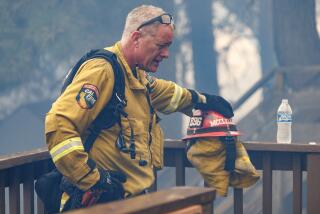Saving money on air tanker may cost millions
- Share via
The budget Gov. Arnold Schwarzenegger signed Tuesday canceled the contract for California’s largest firefighting tool, a DC-10 jet, to save $7 million. But the long-term cost to taxpayers could far exceed the savings.
Depending on the severity of this fire season, California could potentially spend millions more for aerial firefighting, already one of the most expensive components in wildland firefighting, according to a state analysis.
The budget eliminates the cost to keep a DC-10 available to state fire managers at any moment, regardless of whether it was used. It was replaced with a contract for two DC-10s on a pay-as-you-go basis, but at a higher hourly rate.
In addition, California entered into a deal to use an even bigger firefighting plane, a retrofitted B-747, that will cost the state a minimum of $1 million every time the jumbo jet is activated.
The analysis by the California Department of Forestry and Fire Protection found that using a DC-10 on an as-needed basis could wind up costing 50% more than currently spent. “If there is an aggressive fire season, it will cost more,” Cal Fire aviation chief Bill Payne said.
The old agreement paid an average of $43,404 a day for the DC-10, regardless of whether the aircraft was used on a fire, according to the state.
Under the new, as-needed contract, the same plane will cost $66,060 a day, payable only when the tanker is called into use. But each time it is dispatched, Cal Fire guarantees to pay the contractor, Victorville-based 10 Tanker Air Carrier, a minimum of three hours each day for a minimum of five days, Payne said. That amounts to about $330,000 each time the aircraft are deployed.
The 747 contract pays Evergreen International Aviation of McMinnville, Ore., a minimum of four hours per day plus fuel, for at least 10 days. That comes to at least $1.187 million each time the 747 is called from its home base in southern Arizona.
Even with the budget cut, California will still have more of the world’s largest firefighting planes available than before, giving fire commanders three large tankers from which to choose. The DC-10s can drop up to 12,000 gallons of water or retardant and the 747 has a payload capacity of 20,000 gallons. Payne said he could envision scenarios in which all three planes could be called into service.
Payne said the state’s fiscal analysts have had their eye on the three-year, $21-million DC-10 contract for months. In total, the fire agency’s budget was reduced by $27 million.
Terence McHale, policy director of the state firefighters union, called the big tanker a “luxury tool.”
“In committee hearings on the budget, we had advocated that if there was going to be a cut that it be to the DC-10,” McHale said.
The big tanker planes are not universally beloved or considered useful in all situations. In March, NASA conducted a series of tests on the DC-10 and 747 and concluded that in certain conditions neither plane would be effective in steep or rugged terrain.
Although the DC-10 has been used on dozens of California fires in recent years, according to 10 Tanker Air Carrier’s Rick Hatton, the 747 only received federal certification after the NASA tests and has never been used on a live fire in the United States.
--
bettina.boxall@latimes.com
More to Read
Sign up for Essential California
The most important California stories and recommendations in your inbox every morning.
You may occasionally receive promotional content from the Los Angeles Times.












